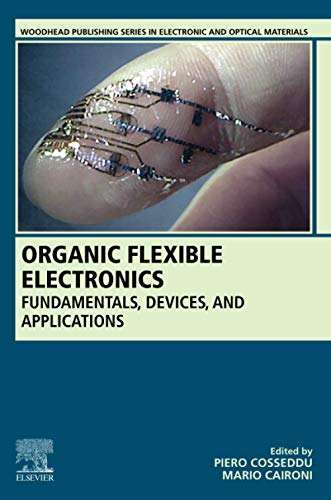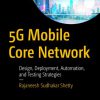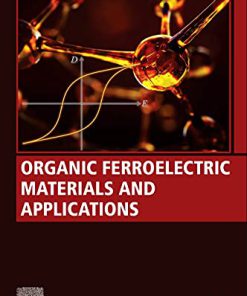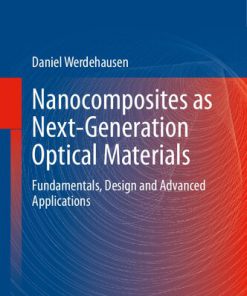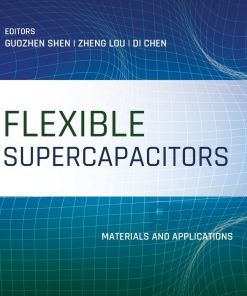Organic Flexible Electronics: Fundamentals, Devices, and Applications (Woodhead Publishing Series in Electronic and Optical Materials) 1st Edition by Piero Cosseddu 9780128188910 012818891X
$50.00 Original price was: $50.00.$25.00Current price is: $25.00.
Organic Flexible Electronics: Fundamentals, Devices, and Applications (Woodhead Publishing Series in Electronic and Optical Materials) 1st Edition Piero Cosseddu – Ebook Instant Download/Delivery ISBN(s): 9780128188903,9780128188910,0128188901,012818891X
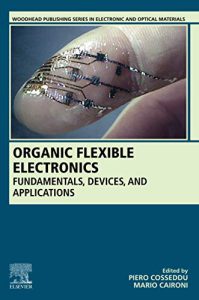
Product details:
- ISBN 10:012818891X
- ISBN 13:9780128188910
- Author: Piero Cosseddu
Organic Flexible Electronics
Fundamentals, Devices, and Applications
- Reviews the fundamental properties and methods for optimizing organic electronic materials including chemical doping and techniques to address stability issues
- Discusses the most promising organic electronic devices for energy, electronics, and biomedical applications
- Addresses key applications of organic electronic devices in imagers, wearable electronics, bioelectronics
Table contents:
1 Fundamentals of organic electronic devices
1.1 Introduction
1.1.1 Physical properties of semiconductors
1.1.2 Technological aspects of semiconductors
1.2 Organic semiconductors
1.3 Basics of organic devices
1.3.1 Photogeneration
1.3.2 Metal/organic interfaces
1.3.3 Metal-semiconductor-metal structures
1.3.4 Current injection into organics: the role of the mobility
1.3.5 Metal-insulator-semiconductor capacitors and transistors
1.4 More on the carrier mobility of organic semiconductors
1.4.1 Hopping transport
1.4.2 High mobility organic semiconductors
1.5 Conclusions
Acknowledgments
References
2 Development of conjugated polymers for organic flexible electronics
2.1 Introduction
2.2 Materials classes
2.2.1 General aspects of donor acceptor copolymers
2.2.2 Conjugated polymer development for organic photovoltaic and organic field-effect transistor de
2.2.3 Conjugated polymer development for organic thermoelectrics
2.2.4 Designing side chains for conjugated polymers
2.3 Synthesis of conjugated polymers
2.3.1 Transition metal-catalyzed cross-coupling reactions
2.3.2 Some aspects about molecular weight and molecular weight determination
2.3.3 Transition metal-free synthesis routes
2.3.4 Chemical defects
2.3.4.1 End group chemistry of conjugated polymers
2.3.4.2 Main chain defects
2.4 Conclusions
References
3 Electronic and ionic transport in organic materials and devices
3.1 Charge transport in organic materials
3.2 Ionic transport in mixed ionic-electronic conductors
3.3 Ionic-electronic coupling in mixed ionic electronic conductors
3.4 Mixed conduction in supercapacitors
3.5 Mixed conduction in bioelectronics
3.5.1 The organic electrochemical transistor
3.5.2 Electrodes
3.5.3 Iontronic delivery devices
3.6 Conclusions
References
4 Chemical doping of organic semiconductors
4.1 Introduction
4.1.1 Inorganic semiconductors
4.1.2 Organic semiconductors
4.2 Doping organic semiconductors
4.2.1 Initial doping approaches
4.2.2 Molecular dopants
4.2.3 Inorganic vs organic semiconductors
4.3 Electronic structure upon molecular electrical doping of organic semiconductors
4.3.1 Electronic structure of charged organic semiconductors
4.3.2 Doping-related ion-pair formation
4.3.3 Ground-state charge-transfer complex formation
4.3.4 Overall electronic structure for both doping scenarios
4.4 Key role of structure in doped organic semiconductors
4.5 Summary and outlook
References
Appendix: Compound abbreviations
5 Interface energetics in organic electronic devices
5.1 Introduction
5.2 Interface energetics
5.3 Ultraviolet photoelectron spectroscopy
5.4 Electronic structure of practical organic thin films
5.5 Energy-level engineering
5.6 Interfaces in organic electronic devices
5.7 Conclusion
Acknowledgments
References
6 Thermoelectric properties of doped organic semiconductors
6.1 Introduction
6.2 Selected experimental results
6.2.1 Charge-carrier concentration dependence
6.2.2 Thermopower versus conductivity
6.2.3 Morphology
6.2.4 Anisotropy
6.2.5 Relative energy levels
6.3 Density of states
6.4 Boltzmann transport equation
6.5 Analytical models
6.6 Mott–Martens model
6.7 Schmechel–Ihnatsenka model
6.8 Kang–Snyder model
6.9 Semicrystalline polymers in the low disorder limit
6.10 Quasiatomistic models
6.11 Outlook
Acknowledgments
References
7 Mechanical properties of organic semiconductors for flexible electronics
7.1 Introduction
7.2 Mechanical testing methods
7.2.1 Sandwiched beam tests
7.2.2 Film-on-elastomer method
7.2.3 Pseudo-freestanding tensile testing
7.3 Mechanical properties of organic semiconducting materials
7.3.1 Summary of fracture energy
7.3.2 Summary of tensile properties measured by pseudo-freestanding tensile testing
7.4 Impact of various factors on mechanical properties of conjugated polymers
7.4.1 Effects of molecular structures: fused rings, isolated rings, and side chains
7.4.2 Effects of crystallinity
7.4.3 Effects of molecular weight
7.4.4 Effects of material type and composition in blend thin films
7.4.5 Effects of film morphology
7.4.6 Effects of environmental conditions
7.5 Conclusion
References
8 Flexible barriers and packaging
8.1 Introduction to device packaging
8.2 Permeation in thin films
8.2.1 Models to describe gas permeation at layer defects
8.2.2 Moisture and oxygen permeation
8.3 Types of encapsulation
8.3.1 Glass-to-glass package
8.3.2 Thin-film encapsulation
8.3.3 Lamination of barrier films
8.3.4 Protective substrates
8.3.5 Encapsulation processes
8.4 Packaging dispensable products
8.4.1 Passive adhesives
8.4.2 Active adhesives and getters
8.4.3 Types of adhesives for device packaging
8.4.4 Current challenges and perspective
8.5 Conclusions
References
9 Solution-coated barriers for organic electronics
9.1 Introduction
9.1.1 Organic optoelectronics
9.1.2 Vacuum-processed barriers
9.2 Theory of permeation
9.1.3 Temperature dependence
9.3 Measurement of permeation rates
9.1.4 Water vapor permeation measurement
9.1.1.1 Gravimetric method
9.1.1.2 Two-chamber test methods
9.1.1.3 Calcium test
9.1.1.4 Infrared imaging method
9.1.1.5 Electro- and photoluminescence mapping method
9.1.5 Oxygen permeation measurement
9.1.1.6 Atmospheric pressure—manometric method
9.1.1.7 Constant volume method
9.1.1.8 Constant pressure method
9.1.1.9 Carrier gas method
9.1.1.10 Mass spectrometry method
9.1.1.11 Coulometric method
9.1.1.12 Fluorescence method
9.1.1.13 Photodegradation method
9.4 Solution processed barriers
9.1.6 Reducing coefficient of diffusion (D) and solubility (S)
9.1.7 Increasing effective path length by tortuosity
9.1.1.14 Modeling and simulation of barrier characteristics of filled polymers
9.1.1.15 Clay-based barriers
9.1.1.16 Graphene-based barriers
9.1.1.17 Glass flakes-based barriers
9.1.8 Reducing effective area (A) by impermeable layers
9.1.1.18 Silica-related coatings (sol–gel, ORMOCERs)
9.1.1.19 Graphene oxide
9.1.9 Reducing the concentration of permeant
9.5 Summary
References
10 Inkjet printed organic and perovskite photovoltaics—review and perspectives
10.1 Introduction
10.1.1 New solar cell applications
10.1.2 OSC technology
10.1.3 PSC technology
10.1.4 Inkjet technology
10.1.4.1 Inkjet types
10.1.4.2 Inkjet inks
10.1.4.3 Drop formation and impact
10.2 Literature overview—inkjet printed OSCs and PSCs
10.2.1 OSC active layer
10.2.2 PSC active layer
10.2.3 Electron extraction layer and hole extraction layer
10.2.4 Electrodes
10.3 Perspectives
References
11 Flexible organic thermoelectric generators
11.1 Basic working principles of thermoelectric generator devices
11.1.1 Thermal equivalent circuit of thermoelectric devices
11.1.2 Practical device architecture and its optimization
11.2 Organic thermoelectric generators: materials
11.2.1 p-type organic thermoelectric materials
11.2.2 n-type organic thermoelectric materials
11.3 Organic thermoelectric generators: fabrication techniques
References
12 Flexible organic alkali-ion batteries
12.1 Flexible organic alkali-ion batteries
12.2 Flexible organic electrodes
12.2.1 Flexible organic electrodes for lithium ion batteries
12.2.1.1 Conducting polymers
12.2.1.2 Carbonyl compounds
12.2.1.3 Radical polymers
12.2.1.4 Organosulfides
12.2.1.5 Metal-organic frameworks and covalent-organic frameworks
12.2.2 Flexible organic electrodes for nonlithium ion batteries
12.2.2.1 Prussian blue–based flexible cathodes
12.2.2.2 Carbonyl-based flexible cathodes
12.2.2.3 Carboxylate-based flexible anodes
12.3 Organic electrolytes for flexible batteries
12.3.1 Polymer electrolytes for flexible lithium ion batteries
12.3.2 Polymer electrolytes for flexible nonlithium ion batteries
12.4 Construction of flexible organic full batteries
12.4.1 All organic full batteries
12.4.2 All-solid-state full batteries
12.4.3 Flexible full batteries for stretchable and wearable electronics
12.5 Conclusion and perspective
References
13 3D integration of organic transistors and circuits
13.1 Introduction
13.2 Solution-processed 3D organic transistors
13.3 Flexible and printed 3D organic transistors and circuits
13.4 Scalable 3D integration of dual-gate organic printed transistors and circuits
13.5 Compact modeling and SPICE simulation for 3D organic TFTs and circuits
13.6 Conclusion
References
14 Organic thin-film transistor amplifiers
14.1 Introduction
14.2 OTFT static model as a MOSFET extension
14.3 Unipolar and complementary technologies – an overview
14.4 Unipolar amplifiers
14.4.1 Elementary organic amplifiers
14.4.2 Unipolar high gain stages
14.5 Complementary amplifiers, state of the art
14.6 Double-stage complementary amplifiers
14.7 Conclusions and research outlook
References
15 Ultraconformable organic devices
15.1 Introduction
15.2 Human skin: a complex interface for conformable devices
15.3 Ultraconformability
15.4 Toward ultraconformable electronic systems
15.5 Devices subsystems
15.5.1 Organic thin-film transistors
15.5.2 Sensors
15.5.2.1 Physical sensors
Humidity, temperature sensors
Multifunctional sensing: temperature/pressure—temperature/strain
Pressure sensors
Strain sensors
15.5.2.2 Chemical/biochemical sensors
15.5.2.3 Sensors for electrophysiological recordings
15.5.3 Optoelectronics
15.5.4 Powering
15.5.4.1 Organic photovoltaics
15.5.4.2 Other approaches for powering and storage: supercapacitors, energy harvesting
15.6 Conclusions and perspectives
References
16 Stretchable electrodes for highly flexible electronics
16.1 Introduction
16.2 Mechanical challenges of electrodes for flexible electronics
16.2.1 Strain in flexible electrodes
16.2.2 Stress in flexible electrodes
16.2.3 Optimizing the position of the neutral plane
16.2.4 From flexible to stretchable electrodes
16.3 Stretchable conductor approaches
16.3.1 Structure-enabled electrodes
16.3.2 Thin-film electrodes
16.3.3 Composite-based electrodes
16.4 Transparent flexible and stretchable electrodes
16.5 Failure of bendable and stretchable electrodes
16.6 Conclusions
References
17 Organic biosensors and bioelectronics
17.1 Introduction
17.2 Overview of biosensing
17.2.1 Bioelectronic organic thin-film transistors
17.2.2 Anchoring biomolecules to a surface
17.3 Physical immobilization
17.4 Covalent immobilization
17.5 Bioaffinity immobilization
17.6 Electrolyte-gated transistors: theory and operation
17.7 EG-OTFT biosensors based on the Donnan’s capacitance of anchored biomolecules
17.8 EG-OFET biosensors
17.9 Conclusions
References
18 Neuromorphic computing systems based on flexible organic electronics
18.1 Introduction to neuromorphic and brain-inspired systems
18.1.1 Biological networks and operations in the brain
18.1.2 Typical neuroscience principles targeted when making neuromorphic devices
18.1.3 Motivation for organics
18.2 Neuromorphic devices
18.2.1 Synaptic behavior in the brain
18.2.2 Two-terminal organic devices
18.2.3 Three-terminal organic devices
18.2.4 Electrochemical transistor-based devices
18.2.5 Optical switching devices
18.2.6 Emulating biological functions
18.2.7 Chemically responsive devices and systems
18.3 Toward biophysical realism in neuromorphic systems
18.3.1 Mimicking specific circuitry found in the brain (i.e., oscillatory functions)
18.3.2 Global oscillations of integrated systems
18.4 Emulating ANN algorithms with neuromorphics
18.4.1 What is an artificial neural network?
18.4.2 Crossbar array concept and architecture
18.4.3 Range of conductance states
18.4.4 Long-term plasticity and state retention
18.4.5 Cycling endurance
18.4.6 Operating currents and switching energy
18.4.7 Operating speeds
18.4.8 Temperature resilience
18.5 Integration with biology and future outlook
References
19 Flexible and large-area imagers using organic photodetectors
19.1 Introduction
19.2 Organic photodetectors
19.3 TFT backplane technology
19.3.1 Amorphous silicon transistor backplanes
19.3.2 Organic transistor backplanes
19.3.3 Amorphous oxide transistor backplanes
19.4 Medical X-ray detector
19.5 Biometric imaging
19.6 Summary
Acknowledgments
References
20 Flexible and wearable monitoring systems for biomedical applications in organic flexible electron
20.1 Introduction
20.2 Biomechanical monitoring
20.3 Biopotential recordings
20.4 Tattoo biomonitoring: the last frontier of wearable
20.5 Flexible biosensing and cell-monitoring technologies
20.6 Conclusions
People also search:
organic flexible electronics
flexible organic electronics in biology materials and devices
all-organic flexible fabric antenna for wearable electronics
organic electronics flexible display
organic transistors for flexible electronics
You may also like…
Chemistry - Inorganic Chemistry
Engineering - Industrial Engineering & Materials Science
Advanced Materials for Printed Flexible Electronics 1st Edition Colin Tong
Technique - Electronics
Electronic Devices, Circuits, and Applications 8th Edition by Christopher 9783030805371 3030805379
Engineering - Bioengineering
Engineering - Mechanical Engineering & Dynamics

